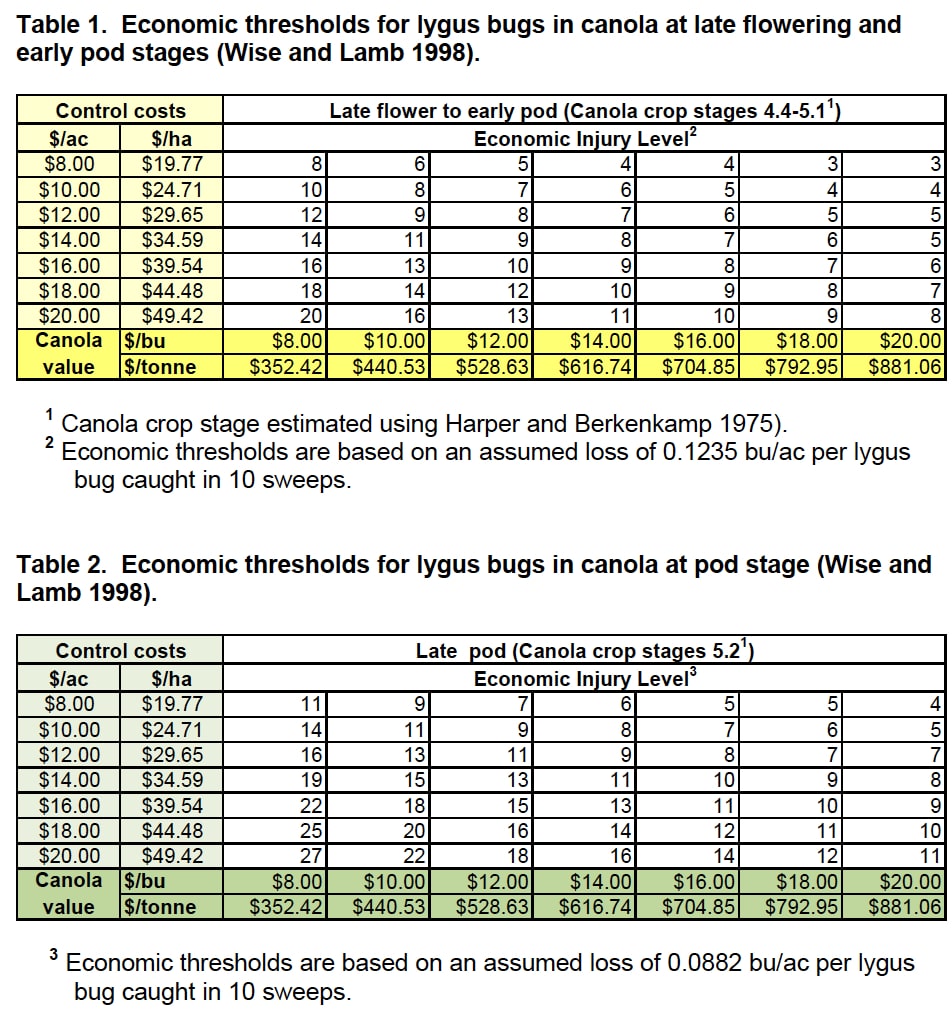Lygus bug spraying at the bud stage rarely provides an economic benefit — even when counts are 15-20 per 10 sweeps.
“Growers are eager to protect their canola given the high prices and generally good growing conditions across the Peace River region this year,” says Greg Sekulic, Canola Council of Canada agronomy specialist for the region. “But we encourage them to scout and monitor and then calculate the real threat before spending time and money on a spray that may not provide an economic return.”
Research has shown that under good growing conditions, canola can produce more buds and branches to compensate for lygus bug feeding at the bud stage.
“Even at high counts of 10 lygus bugs per plant, the research did not show an economic yield loss at this stage,” says Jennifer Otani, entomologist with Agriculture and Agri-Food Canada in Beaverlodge, Alta.
Canola price should not be a factor in the decision. “If there is no yield response to spraying at this stage, it doesn’t matter what the canola price might be,” says Scott Meers, entomologist for Alberta Agriculture and Rural Development.
Lygus bug control at the bud stage can make a difference when densities are high (more than 20 per 10 sweeps) combined with drought conditions that delay the onset of flowering. Densities of up to 50 lygus bugs per 10 sweeps did occur in the Peace region in 2010 and in 1998-99 under very dry conditions.
“But lygus bug feeding that prevents canola from coming into flower is highly unusual, and would be especially unusual this year with the favorable growing conditions now present across most of the Peace region,” says Jennifer Otani, entomologist with Agriculture and Agri-Food Canada in Beaverlodge, Alta. One exception is the north Peace region, which is dry again this year. Growers in that drier area should be scouting for densities that are in excess of 20 per 10 sweeps and that delay the onset of flowering. This combination of factors requires an insecticide application.
Spraying now to prevent feeding at the bud stage is not effective. Bugs present now could still be around at the pod stage, but the hatch has just begun and many more could emerge between now and then. “An insecticide application now won’t control those yet to emerge nor will it control the movement of other adults into the canola as it starts to flower,” Otani says.
Weather will also be a factor. If the weather stays warm and dry, a large lygus bug population could by present by the early pod stage. If rain continues for the next few weeks, many lygus bug nymphs will be knocked to the ground where they can succumb to predators.
The key for growers at this stage is to scout. Keep monitoring dry canola fields that appear to be failing to flower when anticipated.
Scouting tips for the bud stage
Feeding lygus bugs suck on the bud stem and the bud itself, causing bud abortion.
—Whenever possible, sample when it’s warm, sunny and not too windy (e.g., temperatures above 15°C).
—Use a standard insect sweep-net with a 38 cm diameter.
—Take 10, 180 degree sweeps through the canopy of the canola.
—Count lygus bug numbers per 10 sweeps.
If the count is 20 adults per 10 sweeps or higher at 10 locations within the field, and if canola is stressed by drought, then be prepared to keep an eye on this field. If the same field fails to flower when expected and it remains dry, then scout again. Be prepared to apply an insecticide if densities in excess of 20 lygus bugs per 10 sweeps are present in 10 locations within the field. If the same stand flowers when expected, hold off on the spray for now but keep monitoring it into the vulnerable early pod stage.
Besides being a waste of inputs, unnecessary spraying causes undue harm to beneficial insects that help with long-term management of various canola pests. “This doesn’t make good business sense,” Meers says.
Growers are also reminded that tank mixing insecticide when spraying fungicide to prevent sclerotinia may save on application costs, but if the spray provides no yield benefit and harms beneficial insects, it can reduce short- and long-term profitability.
Spray can pay at the pod stage
Lygus bug feeding at the late flower and early pod stages has been shown to result in economic yield losses in canola. At these stages, lygus bug adults and nymphs feed on pods and developing seeds. Canola plants cannot compensate for that type of damage that late in the season.
Economic thresholds are in place for lygus bug feeding at late flower and early pod stages. At these stages, research has demonstrated predictable yield losses when high numbers of lygus bugs are present. At a canola price of $12 and control costs of $12 per acre, a count of 8 lygus per 10 sweeps can warrant a spray at the early pod stage. (See the tables at the bottom for more examples.)
“We want to make sure growers think through every crop protection decision and understand the costs and benefits of each application,” Sekulic says. “Lygus bugs can present a threat to canola yield, but that threat usually comes at the late flower and early pod stages only. Sprays at the bud stage, even if they’re cheap or convenient, are often unnecessary.”
For more on lygus bug scouting, download the Canola Council of Canada scouting card at https://canola-council.merchantsecure.com/canola_resources/product10.aspx

